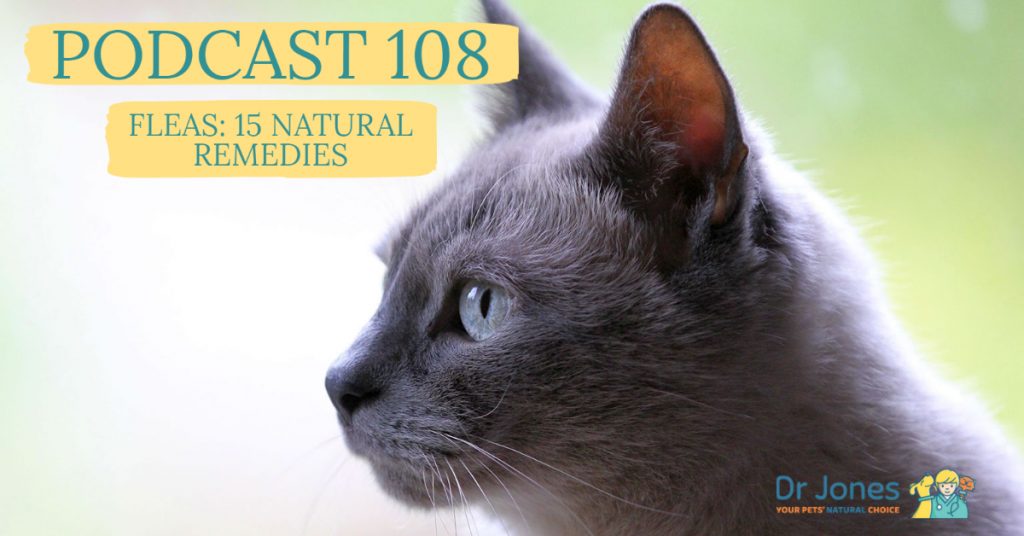[Podcast 108] Fleas: 15 Natural Treatments
Fleas are more than a nuisance, they can actually cause a condition cause blood loss anemia by sucking blood from your pet, and can in advanced cases cause death. It can cause itching, skin infections and hair loss. Some animals can become allergic and get flea allergy dermatitis, and they can also carry parasites.
Common Myths:
#1 – “My pet can’t have fleas, because they live indoors”. Fleas thrive in the well – regulated temperature within the household
#2 – “My pet can’t have fleas, because they would be biting”. Fleas can suck the blood of a variety of animals, but won’t suck the blood of humans unless absolutely necessary
#3 – “My pet can’t have fleas, because I only have hardwood floors”. Fleas can thrive between floor boards!
#4 – “My pet can’t have fleas, because I’d see them”. Many animals will lick, bite and chew at the fleas, meaning they are ingested most often
Flea Allergy Dermatitis an allergic reaction where the body’s immune system is overreacting to the antigen in the flea’s saliva, and is a leading cause of flea allergies. A single flea bite can be itchy for days, and most cases are diagnosed between 2-5 years. You’ll notice hair loss at the base of the tail, and an itchy dog.
You’ll want to look at strict flea control and prevention of fleas. Supplementing with a high dosage of essential fatty acids, licorice root for itch relief, and natural antihistamines such as nettle tea. To start, having a healthy animal to begin with will lessen your chances of them getting fleas. Boosting your pets immune system, and flea combing your pet frequently to pick up fleas, eggs and feces. Bathing is effective in reducing fleas, try using a pet shampoo with added oatmeal for soothing, twice per week. Make sure the shampoo does not contain tea tree oil, as this can be toxic to cats – shampoos with neem oil and cedar oil can help.
15 Natural Remedies to get rid of fleas:
Brewer’s Yeast and Garlic – to make their skin taste bad. Give 1/4 tsp garlic 1/4 tsp of brewers yeast daily for a 10/lbs dog.
Mullein – is an herb you can use topically, steep a handful of dried herbs to make a tea, and pour cooled tea over your pet to temporarily paralyze the fleas.
Cedar Oil spray – Being cautious with spraying your pet with essential oils, lightly mist them with the spray, and use a flea comb to spread the spray around. TripleSure Natural Flea and Tick Spray for Dogs and Cats is a spray I recommend, or I have a recipe to make your own at home on my YouTube Channel, which is linked below.
Diatomaceous Earth – is made from fossilized organisms called diatoms. It’s meant for oral consumption, but lightly dusting your pet weekly and brushing through with a flea comb to spread can stop fleas.
Coconut Oil – the lauric acid found in coconut oil has been found to be a great insect repellent. Give your pet 1/4 tsp for every 10/lbs of weight daily orally, as well as applying a small amount in the fur daily to act as a repellent daily.
My Natural Anti-Flea and Tick Spray– watch my video below for my recipe!
Nootkatone – is a natural compound found in the Alaskan Yellow Cedar Tree, and grapefruit peels
Neem Oil – has insecticidal properties, among many other uses. You can take 1 tsp neem oil, 2 mls of mild natural soap (such as castile soap), about 2 cups of warm water. Mix warm water with the soap first, then add neem oil – then shake and lightly spray over your pet.
Flea control – Make sure you’re regularly cleaning areas your pet stays in – washing your pets bed, and vacuuming and cleaning areas like bedding, car and carpets. Steam cleaning is ideal, but thoroughly vacuuming will work, just make sure you’re getting into nooks and crannies.
Dehumidify – Fleas thrive in humid areas.
Flea Control in Yard – keep your grass short to let the sun kill the larvae.
Garlic Barrier – a strong liquid garlic extract to repel insects in gardening. This is an FDA approved repellent for your garden.

Is this more of a repellent or something that will kill the fleas?
I know the diatomaceous earth kills them.